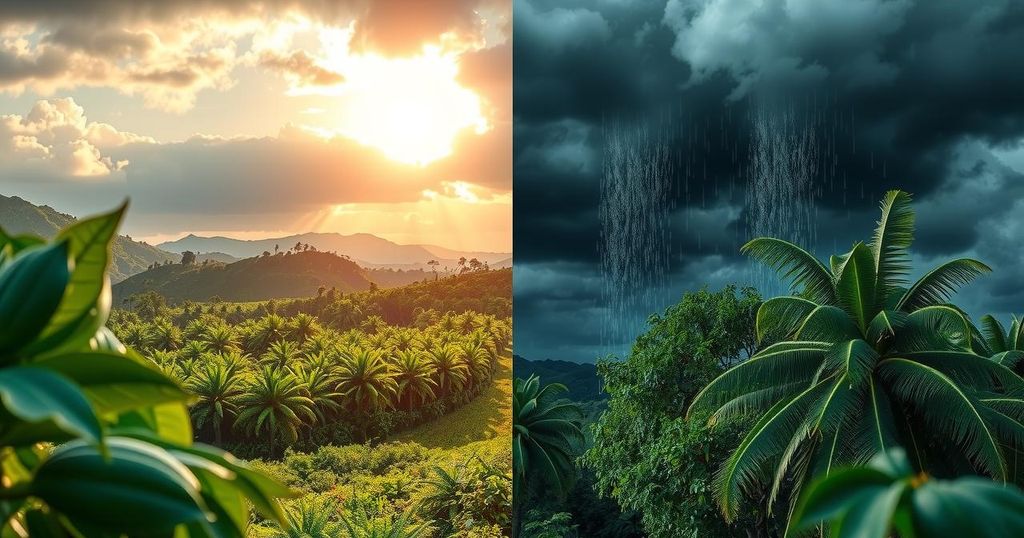The Impact of Climate Change on Valentine’s Day Chocolate
Valentine’s Day spending in the U.S. is on the rise, with chocolate consumption expected to reach 58 million pounds this year. However, climate change is jeopardizing cocoa production by causing unpredictable weather patterns that affect yields. Farmers are adopting new strategies to adapt, but consumer choices can also influence sustainability in the chocolate industry. Rising cocoa prices due to agricultural challenges indicate higher costs for chocolate this Valentine’s Day.
Valentine’s Day spending in the United States continues to rise, reaching nearly $26 billion in 2023 and expected to surpass $27.5 billion this year, with a significant portion allocated for candy, particularly chocolate, which represents 11.2%. Americans are projected to consume approximately 58 million pounds of chocolate during this festive week. However, despite its popularity, cocoa production is facing challenges leading to increased prices. Jessica Fanzo, a climate expert and director at the Columbia Climate School’s Food for Humanity Initiative, highlights the necessary conditions for cacao trees and how climate change complicates chocolate production.
Cacao trees thrive in warm, humid environments with reliable rainfall, primarily found in tropical regions close to the equator. Major cocoa producers include areas in Southeast Asia, Central and South America, and notably West Africa, which contributes about 70% of global production. These trees take 3 to 5 years to yield their first pods, followed by another 5 years for peak production. Unfortunately, climate change disrupts this timeline, presenting additional hurdles for farmers who depend on specific cultivating practices.
Climate change adversely affects cocoa production through unpredictable weather and variability, causing droughts that induce water stress and reduced yields. Excessive rainfall can lead to diseases affecting cacao trees, while high temperatures exacerbate moisture loss in the soil, leading to poor crop yields. The increasing heat and aridity of some West African regions pose serious threats to human health and nutrition, forcing some farmers to seek higher altitudes for cultivation amid ongoing disputes over land rights.
Farmers are exploring various adaptation strategies to counteract these climate impacts. New drought-resistant and disease-resistant cocoa varieties are currently being tested in regions such as Ghana and Brazil. Additionally, implementing mixed agroforestry systems, where cocoa is grown alongside shade-giving trees, can help maintain optimal growing conditions. Effective soil and water management practices, including rainwater harvesting, can also mitigate the effects of drought, while precision agricultural tools can aid farmers in better preparing for volatile weather.
Consumers play a crucial role in promoting sustainable practices within the cocoa industry. Purchasing chocolate products with sustainability certifications ensures support for environmentally-conscious farming methods, fair labor practices, and fair wages for farmers. It is vital for consumers to engage in research regarding brands’ sourcing policies and actively advocate for fair trade initiatives and climate action in the chocolate supply chain.
Currently, cocoa prices are experiencing substantial increases due to poor yields in major producing countries, particularly Cote D’Ivoire and Ghana, as a result of adverse climate conditions and disease. Cocoa prices have surged over 300% in the last two years amid low production outputs, market speculation, and sluggish growth in new tree yields. Consumers should prepare for heightened prices when purchasing chocolate for their loved ones this Valentine’s Day.
In summary, climate change poses a significant threat to cocoa production, jeopardizing the quality and quantity of chocolate available for consumption. Farmers are implementing adaptive strategies to counteract these effects, but consumer awareness and support for sustainable practices are essential in promoting a resilient cocoa industry. With rising cocoa prices influenced by various factors, the upcoming Valentine’s Day may see an increase in chocolate costs as a result of these ongoing challenges.
Original Source: news.climate.columbia.edu




Post Comment